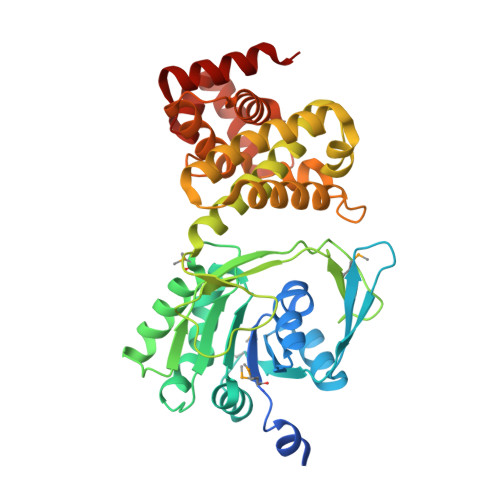Targeting Mannitol Metabolism as an Alternative Antimicrobial Strategy Based on the Structure-Function Study of Mannitol-1-Phosphate Dehydrogenase in Staphylococcus aureus.
Nguyen, T., Kim, T., Ta, H.M., Yeo, W.S., Choi, J., Mizar, P., Lee, S.S., Bae, T., Chaurasia, A.K., Kim, K.K.(2019) mBio 10
- PubMed: 31289190
- DOI: https://doi.org/10.1128/mBio.02660-18
- Primary Citation of Related Structures:
5JNM - PubMed Abstract:
Mannitol-1-phosphate dehydrogenase (M1PDH) is a key enzyme in Staphylococcus aureus mannitol metabolism, but its roles in pathophysiological settings have not been established. We performed comprehensive structure-function analysis of M1PDH from S. aureus USA300, a strain of community-associated methicillin-resistant S. aureus , to evaluate its roles in cell viability and virulence under pathophysiological conditions. On the basis of our results, we propose M1PDH as a potential antibacterial target. In vitro cell viability assessment of Δ mtlD knockout and complemented strains confirmed that M1PDH is essential to endure pH, high-salt, and oxidative stress and thus that M1PDH is required for preventing osmotic burst by regulating pressure potential imposed by mannitol. The mouse infection model also verified that M1PDH is essential for bacterial survival during infection. To further support the use of M1PDH as an antibacterial target, we identified dihydrocelastrol (DHCL) as a competitive inhibitor of S. aureus M1PDH ( Sa M1PDH) and confirmed that DHCL effectively reduces bacterial cell viability during host infection. To explain physiological functions of Sa M1PDH at the atomic level, the crystal structure of Sa M1PDH was determined at 1.7-Å resolution. Structure-based mutation analyses and DHCL molecular docking to the Sa M1PDH active site followed by functional assay identified key residues in the active site and provided the action mechanism of DHCL. Collectively, we propose Sa M1PDH as a target for antibiotic development based on its physiological roles with the goals of expanding the repertory of antibiotic targets to fight antimicrobial resistance and providing essential knowledge for developing potent inhibitors of Sa M1PDH based on structure-function studies. IMPORTANCE Due to the shortage of effective antibiotics against drug-resistant Staphylococcus aureus , new targets are urgently required to develop next-generation antibiotics. We investigated mannitol-1-phosphate dehydrogenase of S. aureus USA300 ( Sa M1PDH), a key enzyme regulating intracellular mannitol levels, and explored the possibility of using Sa M1PDH as a target for developing antibiotic. Since mannitol is necessary for maintaining the cellular redox and osmotic potential, the homeostatic imbalance caused by treatment with a Sa M1PDH inhibitor or knockout of the gene encoding Sa M1PDH results in bacterial cell death through oxidative and/or mannitol-dependent cytolysis. We elucidated the molecular mechanism of Sa M1PDH and the structural basis of substrate and inhibitor recognition by enzymatic and structural analyses of Sa M1PDH. Our results strongly support the concept that targeting of Sa M1PDH represents an alternative strategy for developing a new class of antibiotics that cause bacterial cell death not by blocking key cellular machinery but by inducing cytolysis and reducing stress tolerance through inhibition of the mannitol pathway.
Organizational Affiliation:
Department of Molecular Cell Biology, Institute for Antimicrobial Research and Therapeutics, Sungkyunkwan University School of Medicine, Suwon, South Korea.
















